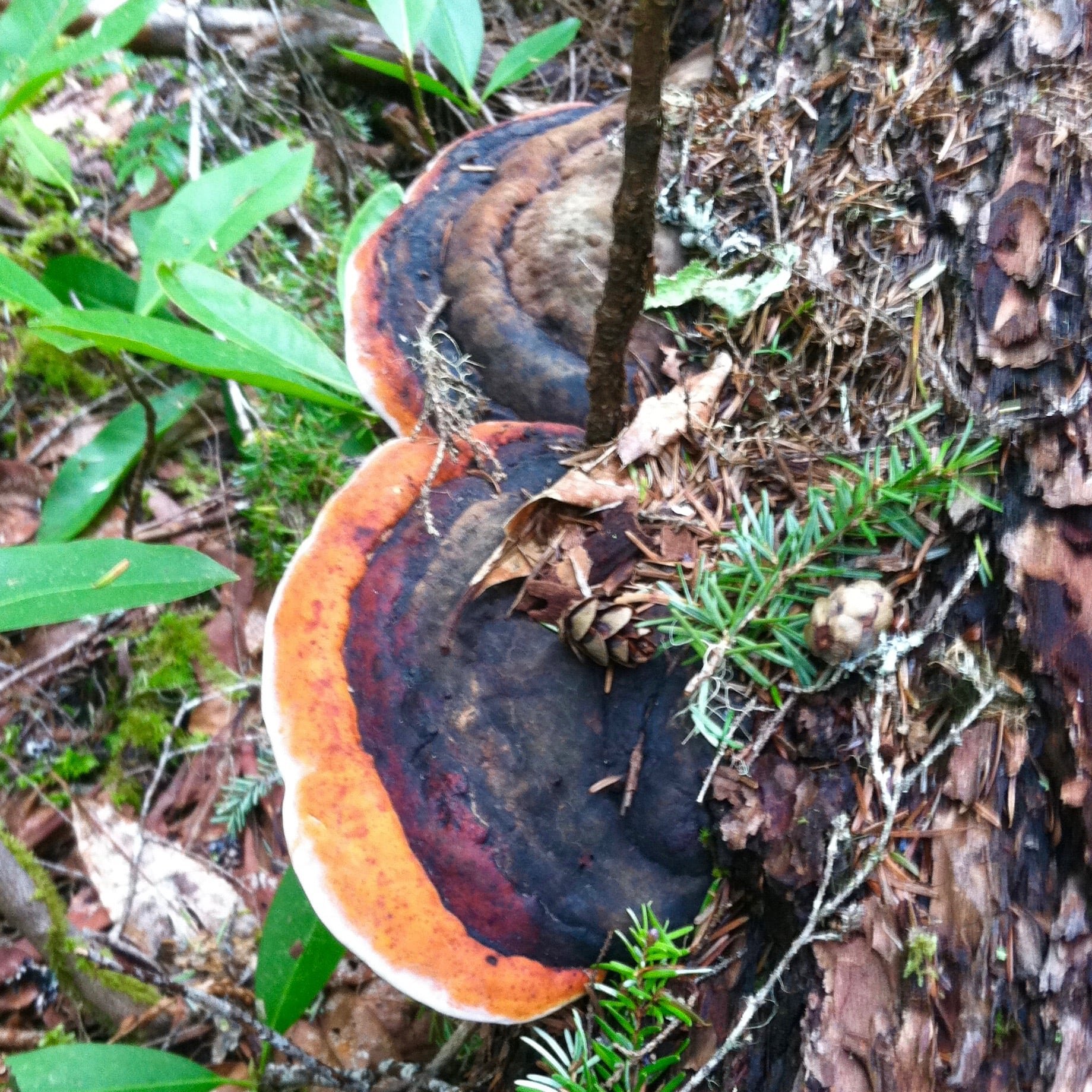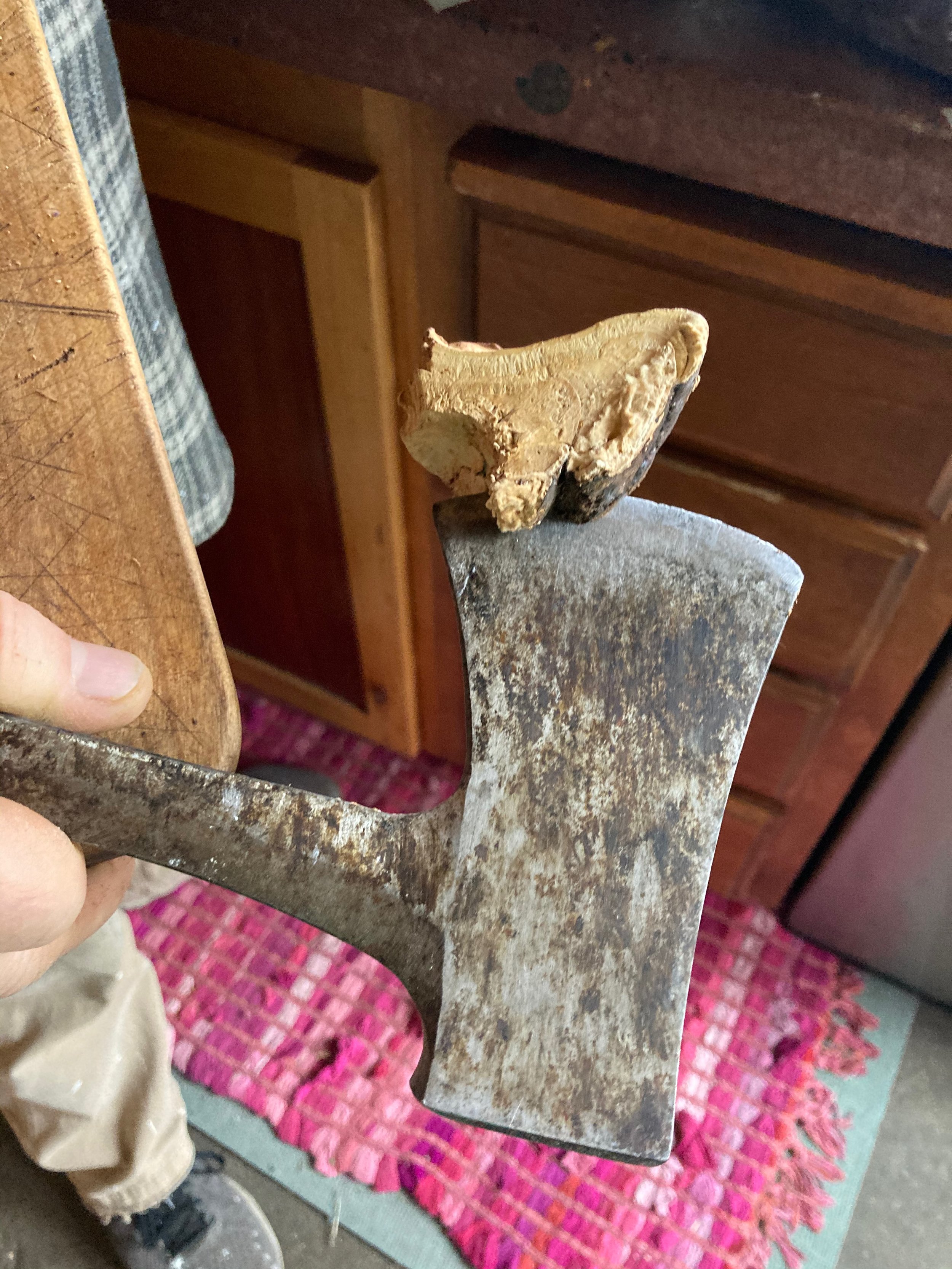
Red-Belted Conk
Red-Belted Conk is serious forest food for your wellbeing. Historically used to reduce digestive tract inflammation, boost the immune system, and inhibit the growth of tumors, this fungus is a delight to harvest and a mainstay in our home apothecary.
Identifying Red-Belted Conk
Red-Belted Conk is a shelf mushroom that grows on conifers throughout North America. These polypores can be found on stumps, fallen logs, standing trunks, and sometimes living trees. We harvest our Red-Belted Conk in the ancient fir forests along the Breitenbush River in the Central Cascade Mountains of Oregon.
They look like little brownish-orange gnome hats peeking halfway out from tree bark, and have a solid corky texture. So solid, in fact, that Seth often has to use a hatchet to break them up when it’s time for medicine-making!
Harvesting Red-Belted Conk
The superpowers of the Conk are most potent in the fall. Harvest by pressing down on the cap. If extra help is needed, try prying it off with a knife, then cut into chunks as soon as possible so you don’t have to resort to ye old hatchet.
Red-Belted Conk for Immune System and Digestive Support
Like so many fungi, Red-Belted Conk provides excellent support to the immune system. According to herbalist Scott Kloos, it “stimulates the production of white blood cells, … inhibits the growth of cancerous tumors, and lessens gastrointestinal inflammation.” In addition, he recommends conk tea and/or tincture to help with autoimmune conditions like rheumatoid arthritis and to soothe the effects of chemotherapy.
As a powder, Red-Belted Conk was traditionally used to slow blood loss from wounds. It was also used for fevers, enlarged spleen, chronic diarrhea and dysentery, and nervous headaches.
How to Use Red-Belted Conk at Home
Using the hatchet to break up dried conk.
If you have access to wild Red-Belted Conk, treat yourself to a forested foraging adventure! The journey, itself, is an important part of the medicine.
Once you get your Conk cap home, you can make tea, tincture, or broth out of it.
For tea: You’ll need to do a long decoction to extract all its goodness. In a saucepan, combine 2 parts by weight of cubed conk with 32 parts by volume of cold water. In other words, combine 2 oz. of Conk by weight with 32 fluid oz. of water. Add 1 tablespoon of coconut or olive oil per 32 oz. water to maximize the extraction. Bring to a boil, cover the pot, lower the heat, and simmer over very low heat for at least two hours, then strain when it’s ready. Like all medicinal teas, drink within 24 hours or freeze. You can also use this tea in a nourishing soup broth.
For Tincture: In a jar, combine 1 part cubed Conk by weight with 12 parts menstruum by volume. Menstruum is the alcohol mixture used to extract the medicinal properties of herbs. 100-proof alcohol is ideal for Conk, but 80-proof vodka from the store will do. If you do have access to Everclear or an organic version, combine it with water in a 1:1 ratio for a 100-proof menstruum. Combine your Conk with the alcohol in a jar, label it well, give it a good shakey shake, and place it in a cool dark place for 4-6 weeks, shaking regularly.
And just to give you a concrete example of these math-y instructions: If you have 2 oz. by weight of Conk, you’ll need 24 fl. oz. of menstruum (alcohol).
After 4-6 weeks have passed, strain your tincture, put some in a dropper bottle, and take 30-60 drops up to three times per day. When combined with the tea, you get the full wellness spectrum of this potent fungus.
You can also simply buy Red-Belted Conk tincture from our apothecary!
Resources
Kloos, Scott. 2017. Pacific Northwest Medicinal Plants. Timber Press: Portland, Oregon.
Disclaimer
For educational purposes only. This information has not been evaluated by the Food and Drug Administration. This information is not intended to diagnose, treat, cure, or prevent any disease.


